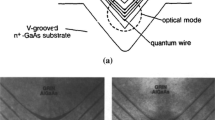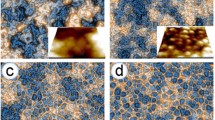Abstract
Mesa structures fabricated on Si(111) surfaces have been found experimentally to develop step arrays with large spacing of the order of a micron or more after annealing at temperatures where sublimation becomes important. Ridges around the edges initially develop during annealing and form barriers to step motion before eventually breaking down. This produces an array of steps of the same sign with a few wide terraces. Computer simulations using one dimensional Burton, Cabrera and Frank (BCF) theory including attachment-detachment rates and step-step repulsion for this configuration show that the terraces evolve under different dynamics depending on the terrace widths. For large terrace widths, sublimation dominates the step dynamics and the Ehrlich-Schwoebel effect is negligible. Sinusoidal terrace width distributions result in this case. The experimentally measured step distribution has such a sinusoidal shape suggesting that the step dynamics is sublimation dominated on the mesas after ridge breakdown.
Similar content being viewed by others
References
K.-C. Chang and J. M. Blakely, in Mat. Res. Soc. Symp. Proc., (2002), Vol. 749, W16.5.
Z. L. Liau and H. J. Zeiger, J. Appl. Phys. 67, 2434 (1990).
W. W. Mullins, J. Appl. Phys. 28, 333 (1957).
W. W. Mullins, J. Appl. Phys. 30, 77 (1959).
G. S. Rohrer, C. L. Rohrer, and W. W. Mullins, J. Am. Ceram. Soc. 84, 2099 (2001).
W. W. Mullins and G. S. Rohrer, J. Am. Ceram. Soc. 83, 214 (2000).
N. Combe, P. Jensen, and A. Pimpinelli, Phys. Rev. Lett. 85, 110 (2000).
W. K. Burton, N. Cabrera, and F. C. Frank, Philos. Trans. R. Soc. of London Ser. A 243, 299 (1951).
K.-C. Chang and J. M. Blakely, Surf. Sci., To be published (2005).
C. Misbah and O. Pierre-Louis, Phys. Rev. E 53, R4318 (1996).
M. Sato and M. Uwaha, Phys. Rev. B 51, 11172 (1995).
Acknowledgments
This work is supported by the Cornell Center for Materials Research and by NSF grant no. DMR-0109641. The authors would like to acknowledge the extensive use of the Cornell Nanofabrication Facility in making the patterned Si(111) samples.
Author information
Authors and Affiliations
Rights and permissions
About this article
Cite this article
Chang, KC., Blakely, J.M. Spontaneous Formation of Ridges on Patterned Mesas and Their Role in the Evolution of Step Arrays. MRS Online Proceedings Library 854, U2.5/JJ2.5/KK2.5 (2004). https://doi.org/10.1557/PROC-854-U2.5/JJ2.5/KK2.5
Published:
DOI: https://doi.org/10.1557/PROC-854-U2.5/JJ2.5/KK2.5




